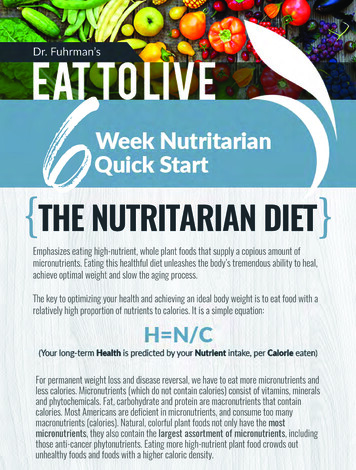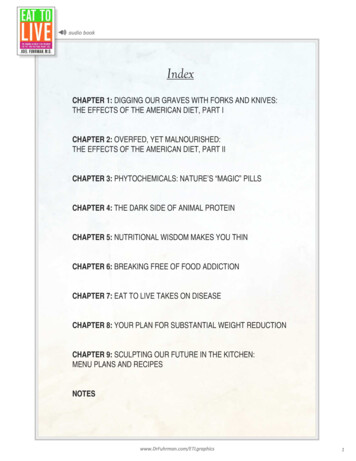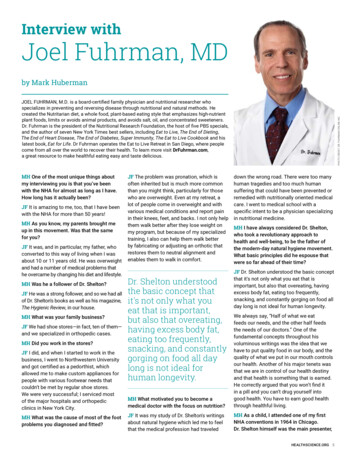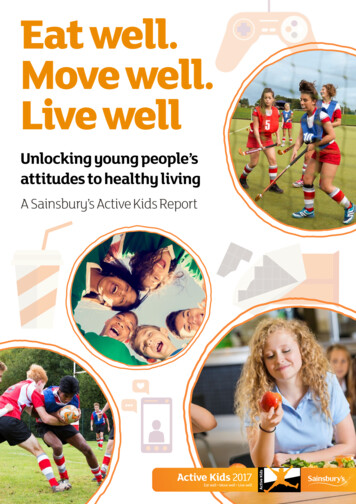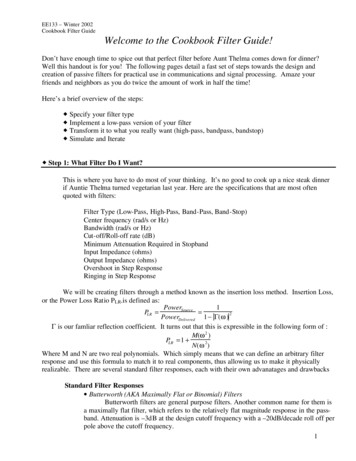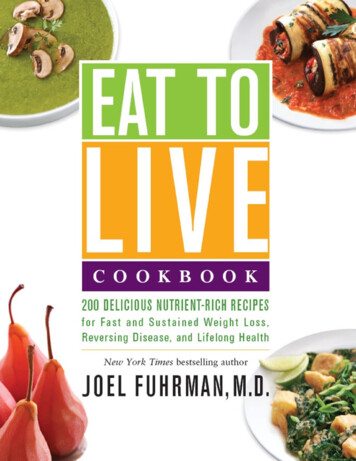
Transcription
CONTENTSWelcomeIntroductionThe Best IngredientsCook to LiveOur Guest ChefsRecipes*Smoothies, Blended Salads, and JuicesBerry Banana SmoothieApple Oatberry SmoothieSuper Easy Blended SaladChocolate Cherry SmoothieGreen GorillaBoston Green SmoothieOrange Creamsicle Blended SaladPurple Monster SmoothieHigh Cruciferous JuiceImmunity Power JuiceDetox Green TeaPomegranate RefresherBreakfastBlueberry Nut OatmealOvernight OatmealQuick Banana Berry Breakfast To GoQuinoa Breakfast PuddingButternut Blueberry BreakfastSlow Cooker Eggplant BreakfastButternut Breakfast Soup
Apple SupremeFruity Breakfast SaladTuscan Tofu ScramblePolenta FrittataAM (Avocado and Mango) Lettuce WrapAntioxidant-Rich Breakfast BarsBerry Explosion MuffinsSalad DressingsAlmond Balsamic VinaigretteNutritarian Caesar DressingBanana Walnut DressingBlueberry Pomegranate DressingGreen Velvet DressingGinger Almond DressingTen Thousand Island DressingCreamy Roasted Garlic DressingOrange Peanut DressingPesto Salad DressingRussian Fig DressingGuacamole DressingDips, Chips, and SaucesBlack Bean and Corn SalsaFresh Tomato SalsaFavorite GuacamoleIsland Black Bean DipRoasted Eggplant HummusTuscan White Bean DipMushroom Walnut PâtéHerbed “Goat Cheese”Pita/Tortilla CrispsKale Krinkle ChipsBrown Cremini GravyTornado Tomato SauceBlueberry Blast SauceSesame Ginger SauceArugula PestoNutritarian Pickling Juice
SaladsMixed Greens and Strawberry SaladShredded Brussels Sprouts SaladApple Bok Choy SaladSpiced Pumpkin Seed Cabbage SaladOrange Sesame Micro SaladSuper SlawDijon Vinaigrette AsparagusMarinated Mushroom SaladSalad of Roasted Beets and Asparagus with Black Cherry VinaigretteQuinoa Mango SaladThree Bean Mango SaladWarm Braised Belgian Endive Salad with Raspberry VinaigretteJamaican Jerk Vegetable SaladChickpea “Tuno” SaladBeluga Lentil EscabecheWild Rodeo SaladTaco Salad with Guacamole DressingWilted Arugula MilaneseCrazy-For-Kale Salad with Dijon Pumpkin Seed DressingWarm Spiced Butternut Squash Salad with Winesap ApplesGinger-Poached Butternut Squash Salad with Warm Ginger Raisin DressingSoups and StewsHomemade Vegetable BrothAcorn Squash Stew with Brussels SproutsBlack Forest Cream of Mushroom SoupBroccoli Mushroom Bisque“Cheesy” Kale SoupChunky Sweet Potato StewQuick Corn and Bean MedleyCream of Asparagus SoupCreamy Zucchini SoupDr. Fuhrman’s Famous Anticancer SoupUkrainian Sweet and Sour Cabbage SoupFrench Minted Pea SoupGolden Austrian Cauliflower Cream SoupCruciferous Vegetable Stew
Very Veggie StewPersian Chickpea StewShiitake Portobello StewShiitake Watercress SoupTomato BisqueThree Sisters Harvest StewToo-Busy-To-Cook Vegetable Bean SoupWest African Lentil Okra StewTuscan Cannellini Bean Soup with a Chiffonade of Collard GreensYellow Lentil Dal with MangoGazpacho Summer SoupWatermelon GazpachoBlack Bean and Butternut Squash ChiliCrock Pot Mushroom ChiliGoji Chili StewMain DishesThai Vegetable CurryAsian Vegetable Stir-FryMushrooms and Beans over Crispy KalePistachio-Crusted Tempeh with Balsamic-Glazed ShiitakesSpicy Thai Braised Kale and TofuCremini RatatouilleTofu Fillets with Mushroom Wine SauceOven-“Fried” Tofu with Jicama Mango Slaw and Sweet Potato SticksEggplant Cannelloni with Pine Nut Romesco SauceNo-Pasta Zucchini LasagnaSweet Potato “Lasagna” with Swiss Chard and Arugula Walnut PestoGarden-Stuffed VegetablesSicilian Stuffed PeppersThanksgiving Nonmeat LoafArtichoke Lentil LoafVegetable Shepherd’s PieVegetable TagineSpinach with Mushrooms and LeeksBraised Kale and Squash with Pumpkin SeedsCalifornia Creamed KaleCreamed Forest Kale over Wild Rice
Great GreensOrange Zest ChardSwiss Chard and Beans ItalianoBrussels Sprouts with Orange and WalnutsBrussels Sprouts with Butternut Squash and CurrantsBroccoli Fra DiavloCauliflower and Green Pea CurryCauliflower Spinach Mashed “Potatoes”Lemon Cauliflower Risotto“Cheesy” Barley RisottoGreen Beans in a CloudSummer Corn and Tomato SautéMushroom StroganoffMushroom-Stuffed Cabbage RollsPortobello Mushrooms and BeansSpinach-Stuffed MushroomsPolenta with Wilted Greens, Roasted Portobello Mushrooms, and BlackCherry VinaigretteAcorn Squash SupremeSweet Potato and Asparagus RagoutSpaghetti Squash PrimaveraChard and Sweet Potato GratinChanna Saag (Spicy Chickpeas with Spinach)Cuban Black BeansMushroom and Chickpea Sofrito in Rainbow Chard with Spiced Plum SaladRed Quinoa, Roasted Rainbow Carrots, Brussels Sprouts, Pearl Onions, andDulse Salad with Pumpkin Seeds and VerjusBlack Bean Spaghetti and Vegetables with Thai Coconut SauceMediterranean Bean and Kale SautéFuhrman Fast FoodSunny Bean BurgersBetter BurgersSweet Potato Black Bean BurgersKyoto Mushroom BurgersBean EnchiladasVeg-Head Bean BurritoPortobello Veggie Fajitas
Roasted Vegetable PizzaItalian StufferPopeye Pitas with Mediterranean Tomato SpreadPortobello Red Pepper SandwichVegetable Garbanzo WrapsBlack Bean Lettuce BundlesCollard Dijon WrapsKorean Vegetable and Mushroom Lettuce WrapsSpiced Sweet Potato CornbreadNonvegan DishesGarden Eggs and Tofu with SalsaScrambled Veggies and EggsMediterranean Fish StewSalmon and Vegetables in a PacketCreole Chicken and SpinachBlack Bean Turkey BurgersDessertsApple Berrynut BitesChia CookiesGoji Berry Walnut Squares with Chocolate DrizzleSweet Potato Peanut CookiesFudgy Black Bean BrowniesBanana Oat BarsCara’s Apple StrudelHealthy Chocolate CakeCoconut Carrot Cream PiePumpkin Pie with Almond CrustPineapple Strawbana PieNo-Bake Key Lime PieMango PuddingPersimmon PuddingAvocado Chocolate PuddingBerry “Yogurt”Pomegranate Poached Pears with Chocolate and Raspberry SaucesBanana Walnut Ice CreamChocolate Cherry Ice CreamFuhrman Fudgesicles
Peach Apricot SorbetStrawberry Pineapple SorbetRed Velvet SorbetChocolate DipEat to Live for All OccasionsAcknowledgmentsIndexAbout the AuthorAlso by Joel Fuhrman, M.D.Back AdsCreditsCopyrightAbout the Publisher
WELCOMEDEAR READER,Congratulations on being part of the Eat to Live family, a rapidly growingarmy of individuals who embrace a nutritarian lifestyle. This ideal diet-stylecan both maintain our ideal weight and push the envelope of human longevity.Consuming the healthiest foods on the planet gives the best results: mosteffective disease reversal, disease protection, longevity enhancement, and theend of dieting.Eating healthfully also allows us to derive the maximum pleasure andenjoyment out of life. When we eat right, over time, our tastes are modifiedand we truly enjoy and prefer natural foods. Plus, when we know we are eatingfor health, we feel emotionally and intellectually secure in our health destiny,which further enhances our appreciation of the food we eat.I have written this cookbook with the intent of taking the world’s healthiestfoods and making them even more delicious. These recipes come from myhome to yours.From my family to yours, I wish you the best of health, and a long andpleasurable life.Joel Fuhrman, M.D.
INTRODUCTIONEAT TO LIVE IN A NUTSHELLEat to Live is a mind-set, a lifestyle, and the title of my New York Times #1bestselling book, Eat to Live. When you eat to live, you seek foods, recipes,and menus that are nutrient-rich, so the body is supplied with its nutritionalneeds for optimum health, disease prevention, and maximum lifespan.If you want to maintain your good health and enjoy life to the fullest as youage, the secret lies in what you feed your body. Following a plant-based,nutrient-dense diet also enables you to lose weight and keep it off permanently—without hunger or deprivation.If you want to throw away your medications and recover from chronicillnesses, such as heart disease, high blood pressure, and diabetes (all examplesof common illnesses that are more effectively treated with nutritionalintervention than drugs or surgery), then the Eat to Live lifestyle is the mosteffective approach.Uncovering the cause of a disease, when possible, rather than covering upsymptoms with medications, always results in a more favorable outcome.When you maximize nutrients and minimize calories, you become diseaseresistant. Countless studies have shown a relationship between nutrition andcalories and your longevity and health potential. The majority of Americansultimately die from their destructive nutritional extravagances.The most important building block of health is nutrition. Without superiornutrition, your ability to live life to the fullest is limited. Scientific studiesreveal that high-nutrient foods such as vegetables, fruits, beans, nuts, and seedscontain vitamins, minerals, and phytochemicals that work in synergy to allow
us to achieve the best possible health and immunity from disease. Some ofthese nutrients are well known while others have yet to be identified.Unfortunately, most of modern society lives on a low-nutrient diet of emptycalorie, processed, refined foods and high-fat, fiberless animal products. It isno wonder we have an overweight, disease-ridden population dyingprematurely due to nutritional ignorance.All of my dietary advice is based on eating larger quantities of nutrient-richfoods and fewer foods with minimal nutritional value. An optimum dietsupplies fourteen different vitamins, twenty-five different minerals, and morethan one thousand phytochemicals. These plant-based chemicals have profoundeffects on human cell function and the immune system. The foods that arenaturally rich in these nutrients are also high in fiber and water and arenaturally low in calories. They provide what your body needs to maximize itsself-healing and self-repairing mechanisms.Nutrient-rich foods are almost always low-calorie foods.I use a simple formula to express my eating style:H N/CHealth Nutrients/CaloriesYour health is predicted by your nutrient intake divided by your intake ofcalories.H N/C is a concept I call my health equation. It stresses the importance offocusing on the nutrient density of your diet. If your nutrient intake is low andyour calories are high, your health will be only a fraction of what it could be ifyou were consuming a high level of nutrients in each calorie.Food supplies both nutrients and calories (energy). All calories come fromonly three elements: carbohydrates, fats, and proteins. Nutrients, on the otherhand, come from noncaloric food factors, including vitamins, minerals, fiber,and phytochemicals. These noncaloric nutrients are vitally important for yourwell-being. The key to good health and achieving your ideal body weight is toeat predominantly those foods that have a high proportion of nutrients(noncaloric food factors) to calories (carbohydrates, fats, and proteins).Our society has evolved to a level of economic sophistication that allows us
to eat ourselves to death. A diet centered on milk, cheese, pasta, bread, friedfoods, and sugar-filled snacks and drinks lays the groundwork for obesity,cancer, heart disease, diabetes, and autoimmune disease. Although these foodsare certainly harmful, that is not the whole problem. The other important issueis what we are not eating.When we evaluate the standard American diet, we find the calories comingfrom phytochemical-rich foods, such as fresh fruits, vegetables, beans, intactwhole grains, raw nuts, and seeds, are less than 13 percent of the total caloricintake. This dangerously low intake of unrefined plant foods guaranteesweakened immunity to disease, frequent illnesses, and a shorter lifespan. Untilwe address this deficiency, we will never win the war on cancer, heart disease,diabetes, and other degenerative diseases.As I explain in my book Super Immunity:“Super Immunity” can be best defined as the body’s immune systemworking to its fullest potential. Modern science has advanced to the pointwhere we have evidence that the right raw materials and nutritionalfactors can double or triple the protective power of the immune system.Superior nutrition is the secret to super immunity. We are dependent onthe quality of whole foods grown from the earth to sustain us: the healthof the food we eat ultimately determines our own health.Many accept that disease is the result of genetics or luck. The reality is thatthe vast majority of us bear the responsibility for our health through ourdietary choices. Nutrition, exercise, and environment simply overwhelmgenetics. Poor food choices are the largest cause of disease and prematuredeath.Vegetables and fruits protect against all types of cancers when consumed inlarge enough quantities. This is documented by hundreds of scientific studies.The most prevalent cancers in our country are mostly plant-food-deficiencydiseases.Numerous diet plans call for counting calories, eliminating some foods, andadding others, but only this one asks you to strive for more micronutrients in
your diet. This diet-style does not require deprivation. There is no caloriecounting, portion-size measuring, or weighing involved. You eat as much asyou want and, over time, you will be satisfied with fewer calories. As youconsume larger and larger portions of nutrient-dense unprocessed foods, yourappetite for empty-calorie foods decreases and you gradually lose youraddiction to them. At the same time, as the micronutrient quality of your dietincreases, your desire to overeat is curtailed. DON AND HIS WIFE After fighting a losing battle with diabetes on Glucophage, Actos, andGlyburide, and not wanting to start insulin injections, I wanted to learnabout better nutrition, which led me and my wife, who also has diabetes,to Dr. Fuhrman. Together, we learned about his life-changing and lifesaving nutritarian plan. I am now off medication. My energy level isbetter than I can remember, and my A1C is running six. That’s downfrom eleven—all without medication. My wife has lost 34 pounds, and,like me, she’s now medication-free. Thank you, Dr. Fuhrman, for givingus back a quality of life!I have coined the term nutritarian to represent a lifestyle that focuses oneating nutrient-rich, natural foods. Those following a nutritarian dietrecognize that plant foods have disease-preventive, therapeutic, and lifeextending properties. There are many motivations for choosing this lifestyle.You may want to address a current medical concern. You may want to reachand maintain your ideal body weight. You may just want to naturally optimizeyour health and longevity.A NUTRITARIAN LIFESTYLE IS ABOUT:Eating mainly nutrient-dense, natural plant foods: vegetables, fruits,beans, nuts, and seeds.Eating few, if any, animal products (one or two servings per week at
most).Eating no or almost no foods that are completely empty of nutrients ortoxic to the body, such as sugar, sweeteners, white flour, processed foods,and fast foods. ROBERT I was over 400 pounds. I had high blood pressure, high cholesterol,chronic allergies, osteoarthritis, and rheumatoid arthritis. When myfamily doctor diagnosed me as a type 2 insulin-resistant diabetic, Ifinally decided I would no longer be a slave to medicine and poor health.I read all the diabetic literature the doctor gave me and knew right awayit was a bunch of nonsense. So I began doing my own research, whicheventually led to Dr. Fuhrman. So far I have lost 200 pounds andcounting. My cholesterol is normal, my blood pressure is perfect—“low,” according to my doctor. My A1C is now under five, and I haveno signs of diabetes. I threw away all four of my highly toxic arthritismedicines, and now only need to take the occasional OTC Ibuprofen. Myallergies seem to have disappeared, almost entirely. I sold my motorizedwheelchair, and now have a full-time job standing on my feet doingmanual labor.Follow these simple nutritarian guidelines:Include Daily:1. A large salad2. At least one ½-cup serving of beans/legumes in soup, salad, or someother dish3. At least three fresh fruits4. At least 1 ounce of raw nuts and seeds (if you are trying to lose weight,limit to 1 ounce)5. At least one large (double-size) serving of cooked green vegetables
Avoid:1. Red meat and all barbecued, processed, and cured meats2. Fried foods3. Full-fat dairy (cheese, ice cream, butter, whole milk, and 2% milk) andtrans fat (margarine)4. Soft drinks, sugar, and artificial sweeteners5. White rice and white-flour productsThis cookbook provides a selection of recipes designed to complement mydietary recommendations. These recipes have been developed to optimizemicronutrient density, diversity, and completeness. In addition to the wellknown vitamins and minerals, they provide hundreds of other phytonutrientsthat are important for maximizing immune function, preventing cancer andother diseases, and increasing longevity.These are some of my favorites and they have become popular with myreaders, patients, and participants in my Member Support Center (seeDrFuhrman.com/members). If you can eat delicious food that will grant youimproved health, ideal weight, disease protection, and a longer life, whychoose bad food and poor health? If you think healthy food cannot taste good,then try these recipes. What you may find is that food tastes even moredelicious when it makes you the healthiest you can be.
THE BEST INGREDIENTSVEGETABLES TAKE THE PRIZEV egetables, especially green leafy vegetables, win the nutrient density prize.The concentration of vitamins, minerals, phytochemicals, and antioxidants percalorie in vegetables is the highest, by far, of any food. Research shows thatvegetable consumption is the most important factor in preventing chronicdisease and premature death. Unfortunately, the modern American diet isextremely low in natural vegetation, especially vegetables. It is not slightlydeficient in just a handful of micronutrients; it is grossly deficient in hundredsof important plant-derived, immunity-building compounds.Eating a large amount of greens and other colorful vegetables is the secretweapon to achieve great health. They are low in calories and high in lifeextending nutrients. Eat these foods in unlimited quantities and think big. Try toeat a pound of raw vegetables and a pound of cooked vegetables each day. Ifyou can’t eat this much don’t force yourself, but the idea is to completelyrethink what constitutes a portion.Include lots of salads and raw vegetables in your daily meals. Consumingsalads is an effective strategy for weight control. I have treated thousands ofpatients and have observed that the more salad they eat, the more weight theylose. When you add one of my delicious fruit-, nut-, or avocado-baseddressings to your salad, the monounsaturated fats in the dressing increase thebody’s ability to absorb the anticancer compounds in the raw vegetables. Thepowerful combination of raw vegetables and healthful dressings makes salad ahealth food top star.All vegetables contain protective micronutrients and phytochemicals, but
cruciferous vegetables are especially powerful. They are loaded with diseaseprotecting micronutrients and powerful compounds that promotedetoxification and prevent cancer. Cruciferous vegetables have a uniquechemical composition: They have sulfur-containing compounds that areresponsible for their pungent or bitter flavors. When their cell walls arebroken by blending or chopping, a chemical reaction occurs that convertsthese sulfur-containing compounds into isothiocyanates, an array ofcompounds with proven and powerful immunity-boosting effects andanticancer activity.Methods of preparation and cooking affect the absorbability ofisothiocyanates (ITCs). Chop, chew, blend, or juice cruciferous vegetables formaximum production of ITCs. They are not pre-formed in the plant; they aremade when the plant cell walls are chewed or crushed. The more cell walls thatare broken, the more enzymes are released to catalyze the reaction thatproduces these compounds. Cooking does not destroy the activity andfunctions of ITCs; it only deactivates the myrosinase enzyme catalyzing theirformation. That means if you blend, crush, chop, or juice the greens whilethey’re raw and then put the blended or chopped greens into a stew or soup tocook, you will still have those functioning and beneficial compounds presentafter cooking.Onions and mushrooms add great flavor to all kinds of dishes and also havewell-documented anticancer and immunity-building properties. Add them tosoups, stews, stir-fries, and other vegetable recipes. The allium family ofvegetables, which includes onions, garlic, leeks, shallots, chives, and scallions,contains anticancer, anti-inflammatory, and antioxidant compounds. Thisprotection is thought to be due to their organosulfur compounds, which arereleased when the vegetables are chopped, crushed, or chewed.CRUCIFEROUS VEGETABLESArugulaBok choyBroccoliBroccoli rabe
Brussels sproutsCabbageCauliflowerCollard greensHorseradishKaleKohlrabiMustard greensRadishesRed cabbageRutabaga leafSwiss chardTurnip greensWatercressCooked mushrooms contain many unique disease-fighting compounds thatare just beginning to be understood. They empower the body to react quicklyand powerfully when we are exposed to disease-causing pathogens, such asviruses and bacteria. They also contain compounds called aromataseinhibitors, which help to reduce the risk of breast cancer. As a safetyprecaution, mushrooms should always be cooked since some animal studieshave reported toxic effects of raw mushrooms.Frozen vegetables are a convenient option. They are rich in micronutrientsbecause they are picked ripe and flash-frozen right on or near the farm. Feelfree to substitute frozen vegetables in any of your recipes.Many metal cans are lined with a BPA-containing resin. BPA (Bisphenol A),is a chemical linked to a number of negative health effects. I recommend thatpeople avoid canned tomato products because tomatoes are acidic and asignificant amount of BPA could leach into the food. Use fresh tomatoes ortomatoes packaged in BPA-free cartons. Pomi brand, for example, offers bothchopped and strained tomatoes in this type of packaging. Look for tomatopaste packaged in glass jars such as the Bionaturæ brand. I recommendpurchasing the best fresh tomatoes during the tomato growing season andfreezing as many pounds as can fit in your freezer. A box freezer in the garage
is a great investment; it enables you to store summer berries, tomatoes, andother produce, self-grown or purchased in bulk.If you are trying to lose weight, eat as many raw vegetables as desired.Cooked green and nongreen nutrient-rich vegetables (such as eggplant,mushrooms, peppers, onions, tomatoes, carrots, and cauliflower) can also beeaten in unlimited quantities.To get the maximum immune function benefits of cruciferousvegetables, do the following:1. Chew all cruciferous greens very, very well, trying to crush every cell.2. Puree, blend, or chop cruciferous vegetables before adding them tosoups, stews, or other cooked dishes.3. When steaming cruciferous vegetables, such as broccoli or cabbage,try to undercook them slightly so they are not too mushy.4. Add some raw, chopped, cruciferous vegetables to your salad. Theenzymes will increase the production of isothiocyanates.Starchy vegetables include butternut squash, acorn squash, corn, sweetpotatoes, yams, white potatoes, and cooked carrots. They are more caloricallydense than the nonstarchy vegetables and may need to be limited to one servingdaily for those who want to lose weight. Squash has a better nutritional profileand lower glycemic index compared to potato, so it is a better choice if you areoverweight or diabetic. Beans, which I discuss later in this chapter, are evenmore weight-loss and diabetic friendly.Overcooking green vegetables causes them to lose valuable nutrients. Asthe vegetables steam, water-soluble nutrients are lost in the cookingwater. Overcooking also deactivates the beneficial myrosinase enzyme incruciferous vegetables.Do not cook your vegetables longer than the maximum times given inthe ranges below.
Recommended Steaming Times for Green Vegetables:(once water is boiling)Artichokes, halved, choke removedAsparagusBok choyBroccoli, stems separated andquarteredBrussels sproutsCabbage, quartered, leavesseparatedKale, collards, Swiss chardSnow peasString beansZucchiniRange (minutes)16 – 188 – 106–810 – 1210 – 128 – 106–86–89 – 1110 – 12COLORFUL FRUITTry to eat at least three fresh fruits per day. Fruit is an excellent nutrient-dense,low-calorie source of vitamins and phytochemicals. Fruit consumption hasbeen shown to offer strong protection against certain cancers, especially oral,esophageal, lung, prostate, and pancreatic cancers. Researchers havediscovered unique substances in fruit that can help prevent aging anddeterioration of the brain.Berries are especially rich in beneficial phytochemical compounds. Theirhigh antioxidant content helps to reduce blood pressure and inflammation,prevent DNA damage that leads to cancer, and protect the brain againstoxidative damage that can result in degenerative brain diseases. Berries havethe highest nutrient to calorie ratio of all the fruits. All berries, includingblueberries, blackberries, raspberries, goji berries, and strawberries, are superfoods.
Eat a variety of fruits: apples, apricots, bananas, blueberries, cherries,clementines, grapes, kiwis, mangoes, melons, nectarines, oranges, papayas,peaches, pears, pomegranates, raspberries, strawberries, and tangerines. Trysome exotic fruits too, if you have the opportunity. If you need to lose weight,use dried fruits only in small amounts as a sweetener in recipes.Fruit, consumed at its peak of ripeness, is more delicious than anyprocessed, overrefined dessert or treat. Sadly, in the modern world, mostpeople don’t have orchards or gardens full of fresh fruit ready to be picked.Most of the fruit we buy at the grocery store has left the garden far behind,having been picked before its prime to avoid shipping damage and storageloss.To learn how to choose the best fruit, look for color, smell, texture, andweight. Some fruits tell you that they are ripe by their color. As the acidity of afruit changes, the green chlorophyll breaks down. Fruits such as bananas andapples have bright colors underneath the green chlorophyll layer; the colorsshow through as the chlorophyll disappears. Bluish-red berries become adeeper, more intense red as they ripen. For bananas, apples, tomatoes, redberries, and cherries, color change is an excellent indication of ripeness.Smell is especially important when color is not a good indicator of ripeness—for example, with most melons. Chemical changes take place in ripeningfruits that cause them to produce pleasant-smelling compounds. Sniff theblossom end of the fruit (the end opposite the stem) and select fruit that has afull, fruity aroma.As fruits ripen, the substances that hold the cells together break down andconvert to water-soluble pectins, which make the fruit become softer, so agentle squeeze is a good test for ripeness. If a plum is rock hard, it isn’t ripe.The squeeze test is especially useful with fruit that doesn’t have a hard or thickrind, so squeeze stone fruit, pears, kiwis, and avocados. This doesn’t work aswell with melons and pineapples, but even with these hard-coated fruits, a littlegive is a good sign.Weight can be a good indicator of ripe fruit. If a fruit feels heavy for its size,it generally means that the fruit is at least fully mature, which is a good startfor ripeness. A heavy grapefruit or orange, for example, is usually a good one.Frozen fruit is a convenient substitute when fresh fruit isn’t available. Thenutritional value of frozen fruit is comparable to that of fresh fruit. Avoid
canned choices; they are not as nutritious. Often they have added sweetenersand have lost some of their water-soluble nutrients.Since fruit is vital to health and well-being, I use fresh and frozen fruits tomake delicious desserts that are nourishing and taste great. I have includedmany delicious and easy fruit recipes in this cookbook to satisfy your sweettooth and end your meals on a healthy note.How to Eat a MangoChoose a mango that is plump, fragrant, and heavy for its size. Mangoesare ripe when you can indent them slightly with your thumb, but avoidmangoes that are so ripe that they are mushy or have brown marks.Unripe (but not green) mangoes will ripen in a few days when left onyour counter. Refrigerate a ripe mango to make it last longer.In the middle of the mango is a large, flat pit. Holding the mango on itsside, make an initial slice slightly off center (so you miss the pit). Takeanother slice on the other side of the mango. You will now have two“cheeks” plus the pit. Score the two cheeks into cubes. When scoring, cutthrough until your knife reaches the peel, but do not cut through the peel.Scoop out the mango cubes with a large spoon. Dig deeply along theinside of the peel to get out all the fruit. Now take the piece that containsthe pit, peel off the skin and cut off the remaining flesh.GUIDE TO PICKINGTHE BEST RIPE FRUITAPPLESA ripe apple will be firm and deeply colored. Depending on the variety,there should also be a slight rosy tone. If you want to find apples with the
best flavor, buy them during apple season, which spans from latesummer to early winter.AVOCADOSIn the United States, the two common varieties of avocado are usuallyreferred to as California and Florida avocados. The California avocados(also known as Hass avocados) are the ones with pebbly skins that darkenas they ripen. The larger ones with the smooth green rinds are Floridaavocados. California, or Hass, avocados tend to be richer and creamierand make better guacamole. Florida avocados are lighter-tasting andcontain less fat.The best way to get a perfectly ripe avocado is to buy a hard, unripeone. Unlike most fruits, avocados start to ripen only after they arepicked. As they sit in the produce section of the food market, gettingbumped and squeezed by potential customers, the softer, riper fruits maydevelop bruised spots. These unpalatable bruises are hard to detect fromthe outside, especially on the Hass variety,
Joel Fuhrman, M.D. INTRODUCTION EAT TO LIVE IN A NUTSHELL Eat to Live is a mind-set, a lifestyle, and the title of my New York Times #1 bestselling book, Eat to Live. When you eat to live, you seek foods, recipes, and menus that are nutrient-rich, so the body is supplied with its nutritional
